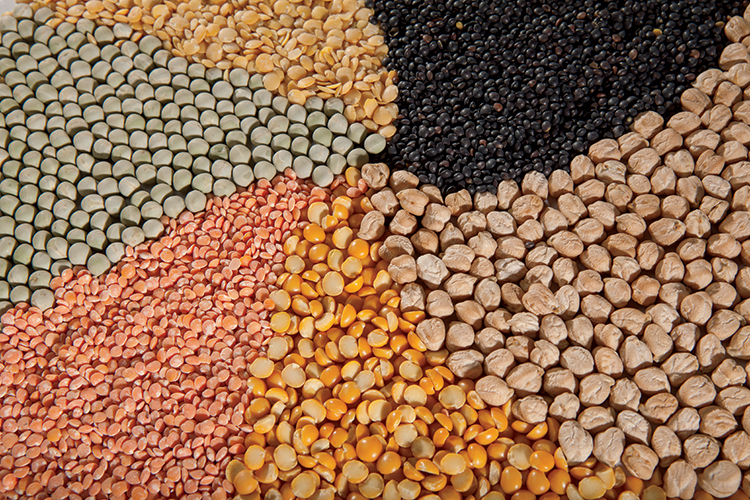Home > Montana > Montana Crops & Livestock > The Pulse of Montana
The Pulse of Montana

Dry peas, lentils and other pulse crops are an excellent fit for Montana,” says Dr. Mary Burrows, assistant professor and extension plant pathology specialist for Montana State University. “Not only do these crops contribute significantly to our economy, but they add nitrogen to the soil, help control pest pressure and make an excellent cover crops for farmers.”
Montana returned to its status as a top producing state for dry peas and lentils over the past few years, and much of the success of this pulse crop is thanks to research being conducted between Montana State University and the Montana Department of Agriculture.
“There is research going on in all areas,” Burrows says. “From how to fit these crops into crop rotation and use as a cover crop, to fungicide resistance and disease prevention. This crop is only going to continue to get stronger.”
Diagnosing Future Problems
Burrows directs Montana State’s Pulse Crop Health Diagnostic Lab, which was funded through the 2014 Farm Bill’s Plant Pest and Disease Management programs. Samples from chickpea, dry pea and lentil growers are examined to ensure the crops are healthy.
“This lab is developing routine diagnostic methods for pulse crops, which can be extended to other legume plant species,” Burrows says. “Our goal is to prevent diseases that could affect these pulse crops by consistent monitoring. The lab offers growers certifications after tests are passed.”
A Good Fit for Wheat Rotation
For years, wheat and barley were raised in a crop fallow rotation in Montana. These monoculture environments often led to various wheat and barley diseases and insect pressure. In recent years, peas
and lentil plants emerged as a favorite rotational crop among farmers and researchers to help battle these problems.
Dr. Perry Miller, professor of sustainable cropping systems at Montana State, has been researching pulse crops for many years. He studies the way dry peas and similar crops may become more diversified in the future.
![Montana Dry Peas and Lentils [INFOGRAPHIC]](https://eadn-wc01-4177395.nxedge.io/wp-content/uploads/2020/05/Screen-Shot-2015-03-11-at-1.39.38-PM.png)
“I’m focused on how peas and lentils fit a wheat-based agriculture system and less on pulse crop agronomy,” Miller says. “We’ve looked at soil water use, nitrogen contribution, yield and quality impact on subsequent wheat crops, as well as completed economic and energetic assessments on longer-term crop rotations.”
Montana has seen a recent explosion in acreage of these pulse crops because of its great fit with wheat, Burrows says.
“It’s a great groundcover plant, and it really keeps the water in the soil between wheat rotations,” Burrows says. “Pulse crops are unique in that they have the ability to add nitrogen to the soil. That nitrogen then cycles into the wheat crop.”
Market Value
Dry peas and lentils are produced mostly for human consumption and occasionally for cattle feed. More than 80 percent of the pulse crops raised in Montana are exported.
“The market demand for these crops is very large and international,” Miller says. “We have a good connection to U.S. food aid programs and a large potential to expand into human health markets.”
The Montana Pulse Advisory Committee and the Montana Department of Agriculture has funded producer workshops to help deliver production and marketing education to growers across the state. These meetings were well attended, and with the producers and elevator managers on board, the market developed quickly.
“Not only have the pulse crops become an important food source for national and international buyers, but the production enhancements have become extremely beneficial to reduce diseases, pests and weed problems in this state,” says Kim Falcon, bureau chief of agricultural development and marketing for the Montana Department of Agriculture.
The Future for Pulse Crops
Miller predicts pulse crop acreage will double over the next 10 years at around 1.5 million acres.
“The positive things they do for soils when in rotation with wheat means they create a more resilient growth response, which should pay dividends over future wet and dry cycles.
“The bigger challenges,” Miller says, “will be in fully developing the marketing infrastructure to support this crop.”




Hi Guys I want to start a pig farming business what I saw is whao. What’s the basic I need before approaching such business. I also like the infrastructure u used I a wear that I need to start small. Please be so kind by giving advice
Please send more info on starting a hog production operation I’v got 312 acres that need fertilizer for crops & I have plenty of water. GREAT pics